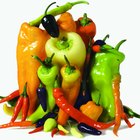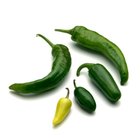
With heat upwards of 50 times greater than that of a jalapeno pepper, habanero peppers make foods extra spicy and are not for everyone. The small peppers are bell- or lantern-shaped and commonly picked when bright orange, though you can find green and red habaneros. Unlike jalapenos that are often stuffed and eaten whole, habaneros are usually added sparingly to kick up the heat in dishes like soups, dips and Latin classics.
Handling
The oil in habaneros can easily burn your skin, so always wear gloves when handling habanero peppers. Remove your gloves and wash your hands thoroughly before touching your skin and especially before you attempt to rub your eyes. While you don't need to resort to wearing goggles, be prepared to dodge juice as you cut habaneros so it doesn't get in your eyes. Wash your knife and cutting board thoroughly after cutting habaneros because the oil and accompanying heat can transfer to other foods.
Removing the Skin
Habanero peppers are covered in a thin, papery skin that's usually unnoticeable when working with fresh peppers. When you eat cooked habaneros, however, the skin tends to separate from the tender flesh and is nearly impossible to break down by chewing. The skin is is fairly easy to remove if you roast the peppers before cutting them. Try fire-roasting habaneros for 5 to 10 minutes on a gas or charcoal grill, or roast them for about 10 minutes in your oven. You can often successfully remove the skins after microwaving the pepper for a few minutes, but they don't benefit from the roasted flavor. After roasting, you can usually rub the skin off, but you might need to start the peeling with a knife.
Controlling the Heat
Most of the capsaicin that makes habaneros hot is concentrated in the seeds, ribs and membrane inside the pepper. Technically, the soft ribs and membrane inside are called the septum and placenta. If you want to make the habaneros as mild as possible, remove the cap, slice the pepper in half and remove all the seeds. You can usually pull the soft ribs away from the pepper flesh, or you can cut them with a paring knife. This is not to say the habenero won't be hot, but it will be much milder than when left whole. If you've never cooked with habaneros before, reserve some of the seeds to add to the dish if it's not hot enough.
Preparation Methods
There are numerous ways to prepare habanero peppers, but perhaps the most common is to saute diced habaneros. Add a bit of oil or butter to a skillet and cook the peppers, stirring frequently, until soft or until they begin to brown. You can toss the sauteed, diced habaneros in chili, tacos, or stir them into fresh salsa. Habaneros pair particularly well with fruit flavors, so try adding them to a mango-peach salsa. You can add thin-sliced habaneros to stir-fry to spice it up. If you really enjoy spicy foods, prepare stuffed habaneros in the same way as stuffed jalapenos. Remove the caps, seeds and ribs and fill the inside with cream cheese. Dip the stuffed habaneros in egg, roll them in bread crumbs and deep-fry them until golden brown.
Related Articles

How to Get Skins Off Peppers

How to Roast & Freeze Habanero and ...

How to Cook a Pasilla Chili

Do Jalapenos Need to Be Refrigerated?

How to Pickle Peppers in Small Batches

Can I Eat the Seeds of a Habanero ...

How to Grind Habanero Peppers

How to make Stuffed Jalapeno Peppers ...

How to Cook Pimentos

How to Roast Poblano Peppers

How to Dry Jalapenos

Hot Pepper Oil & Skin Burn

Does Fire Roasting a Jalapeno Make It ...

How to Use Dry Red Chili Pods

Blanching Jalapenos Before Stuffing

Habanero Peppers & Itchy Skin

How to Preserve Bell Peppers for Use ...

How to Get Breading to Stick When ...
How Many Calories Are in Roasted Red ...

How Much Hotter Is a Habanero Than a ...
References
- Wayne's Word of Palomar College: The Wayne's Word Chile Pepper Edition
- Texas Cooking: Fiery Foods: Habaneros Revisited Cooking With Habanero Chiles
- Habanero Madness: Habanero Pepper Cooking Tips
- The Reluctant Gourmet: Cooking With Hot Peppers
- Fine Cooking: Grilled Tuna Steaks with Mango Habanero Mojo
Writer Bio
A former cake decorator and competitive horticulturist, Amelia Allonsy is most at home in the kitchen or with her hands in the dirt. She received her Bachelor's degree from West Virginia University. Her work has been published in the San Francisco Chronicle and on other websites.
Photo Credits
Jupiterimages/Photos.com/Getty Images